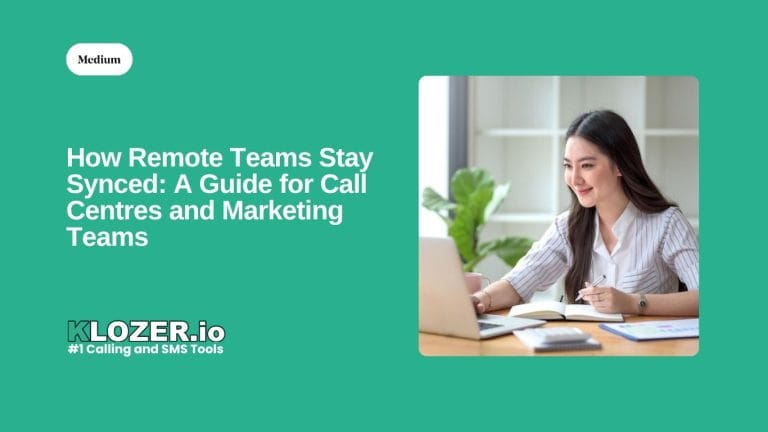Your phone rings. You glance at the screen. “Spam Risk” flashes across it. What do you do? You ignore it, right?
That’s exactly what happens to your outbound calls when people don’t trust your caller ID. Every day, millions of legitimate business calls get ignored because caller ID reputation has become the gatekeeper between you and your prospects.
If you’re in cold calling, telemarketing, or running a call center, caller ID trust isn’t just a nice-to-have. It’s the difference between having conversations and talking to voicemail.
Want To Stop Being Labeled As Spam? Discover How To Build Caller Id Trust And Boost Your Answer Rates Today. Visit Us [www.klozer.io]

What Is Caller ID Trust?
Caller ID trust is how phone carriers and apps rate your phone number. Think of it like a credit score, but for your calling reputation.
When you make calls, phone networks track how people respond. Do they answer? Do they mark you as spam? Do they block your number? All of this data creates a trust score.
If your score is low, your calls get flagged. Labels like “Spam Risk,” “Scam Likely,” or “Potential Fraud” appear on recipient screens. And once that happens, your answer rate drops fast.
How Phone Carriers Judge Your Number
Major carriers like AT&T, Verizon, and T-Mobile use analytics engines to monitor calling patterns. Third-party apps like Truecaller and Hiya add another layer of screening.
Here’s what they watch:
- How many calls you make per day
- How many people answer versus ignore
- How many recipients report your number as spam
- Whether you’re calling numbers on the National Do Not Call Registry
- If your number matches STIR/SHAKEN authentication protocols
One spam report can trigger a warning. Multiple reports get you blacklisted.
Why Does Caller ID Trust Matter for Your Business?
Lower answer rates mean fewer conversations. Fewer conversations mean fewer sales. It’s that simple.
The Real Cost of Being Flagged
A study by First Orion found that by 2024, nearly 50% of all mobile calls are flagged as potential scams. If your number falls into that category, you’re fighting an uphill battle.
Here’s what happens when caller ID trust is damaged:
- Answer rates drop by 60-80% when “Spam Risk” appears
- Your team wastes time dialing numbers that never pick up
- Campaign ROI plummets because you can’t reach decision-makers
- Your brand reputation suffers when prospects see you as untrustworthy
Even if you’re following the rules, aggressive dialing patterns or shared phone numbers can ruin your reputation.
How to Improve Your Caller ID Trust
Building caller ID trust takes consistency and smart calling practices. Here’s how to protect and improve your reputation.
1. Register Your Business with Caller ID Services
Sign up with services like:
- CNAM (Caller ID Name) – Displays your business name instead of just a number
- STIR/SHAKEN – Authenticates your calls as legitimate
- Call attestation programs – Verifies you’re a real business
When your name appears instead of “Unknown,” people are more likely to answer.
2. Monitor Your Calling Patterns
Phone carriers flag numbers that make too many calls in a short time. Spread out your dialing throughout the day.
Best practices:
- Limit outbound calls to 100-150 per day per number
- Avoid calling the same person multiple times in one day
- Rotate between multiple phone numbers to distribute call volume
3. Use Local Presence Dialing
People answer local numbers. Using local area codes that match your prospect’s location can increase answer rates by 30-40%.
But be careful: Don’t fake your location. Use legitimate local numbers and register them properly.
4. Keep Your Numbers Clean
Check if your numbers are already flagged. Use tools like:
- Free Carrier Lookup
- Caller ID Reputation lookup services
- Spam score checkers
If a number is flagged, it’s often easier to get a new one than to repair its reputation.
Struggling With Low Answer Rates? See How Klozer Protects Your Caller Id Reputation And Gets More People To Pick Up. Visit Us [www.klozer.io]

5. Train Your Team on Compliance
Make sure your callers follow telemarketing laws:
- Respect the National Do Not Call Registry
- Always identify your company at the start of the call
- Don’t use robocallers without proper consent
- Honor opt-out requests immediately
Violations don’t just hurt your reputation. They can lead to fines up to $43,000 per call.
What to Do If Your Number Gets Flagged
If your caller ID is already labeled as spam, here’s how to fix it:
Step 1: Stop using the flagged number immediately. Continuing to call from it makes the problem worse.
Step 2: File a remediation request with major carriers:
- AT&T Call Protect
- T-Mobile Scam Shield
- Verizon Call Filter
- Third-party apps like Truecaller
Step 3: Submit evidence that you’re a legitimate business. Include:
- Business registration documents
- Proof of STIR/SHAKEN certification
- Examples of compliant calling practices
Step 4: Get a new number and follow best practices from day one. Prevention is easier than repair.
How Marketing Teams Can Support Call Center Success
Your marketing and sales teams need to work together. Here’s how marketing can help:
- Warm up leads before calling – Send emails or texts first so prospects expect your call
- Use multi-channel outreach – Combine calls with LinkedIn messages and emails
- Set clear expectations – Tell prospects when to expect a call in your marketing materials
- Build brand awareness – The more people recognize your company name, the more likely they’ll answer
When prospects know who you are, they’re less likely to flag you as spam.
The Bottom Line: Protect Your Reputation to Boost Results
Caller ID trust isn’t going away. As spam calls increase, phone carriers and consumers will only get stricter about who they answer.
The good news? You can take control. By following compliance rules, monitoring your reputation, and using smart dialing strategies, you can keep your numbers clean and your answer rates high.
Every ignored call is a lost opportunity. Don’t let a damaged caller ID stand between you and your next sale.
Ready To Improve Your Answer Rates And Protect Your Calling Reputation? Discover How Klozer Helps Call Centers And Sales Teams Connect With More Prospects. Visit Us [www.klozer.io]





